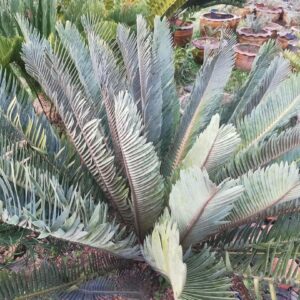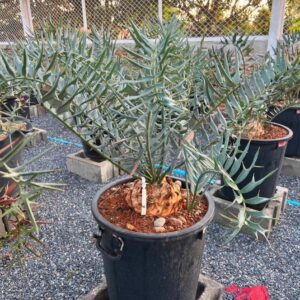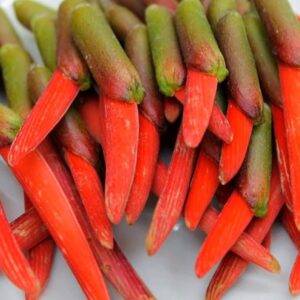Adenia Globosa
Adenia globosa is a unique and fascinating plant species within the Passifloraceae family, native to tropical Africa. It is found in countries such as Ethiopia, Kenya, Somalia, and Tanzania. Here are some key characteristics and uses of this plant:
-
: Adenia globosa is a deciduous shrub or climber with stems that can grow up to 8 meters long. It develops from a swollen, warty, globular trunk, which can be up to 2.5 meters in diameter.
-
: The leaves are small, alternate, and triangular or shallowly 3-lobed, typically 3-7 mm long.
-
: The plant is heavily armed with strong thorns, up to 8 cm long, which develop in the axils of the leaves.
-
: The flowers are greenish-white, unisexual (dioecious), and arranged in axillary cymes. Male flowers are up to 2 cm long with 5 stamens, while female flowers are about 1 cm long with three styles.
-
: The fruit is a green, leathery capsule, typically 1-3 cm long.
-
Adenia globosa grows in dry woodlands, deciduous bushlands, and Acacia-Commiphora bushlands at altitudes ranging from 100 to 1800 meters above sea level.
-
It thrives in African scrub savanna habitats.
-
: Traditionally used in Africa for treating abdominal pain and itching. The Maasai people use it as medicine for their cattle1.
-
: In some regions of Kenya, the plant is used to purify water.
-
: Cultivated and traded as an ornamental plant due to its unique appearance.
-
Adenia globosa can be grown outdoors in frost-free climates. It prefers full sun to light shade, with the caudex in shade and the leaves in sun.
-
It grows slowly but can be encouraged by providing adequate water, warmth, and fertilizer during the active growing season
What are the unique features of Adenia globosa’s caudex
:
-
: The caudex of Adenia globosa is swollen and globular, resembling a large, knobby stone. It can grow up to 2.5 meters in diameter, although some reports suggest it can reach up to one meter in diameter in cultivation.
-
: The caudex is typically warty and bright green, providing a striking contrast to the plant’s thorny stems and small leaves.
-
: The caudex serves as a water storage organ, allowing the plant to survive in arid environments by storing moisture. This feature classifies Adenia globosa as a caudiciform plant.
-
: The caudex is hard and rough, with wart-like protrusions, giving it a unique texture that helps protect the plant from desiccation and predators.
-
: The caudex is the base from which the plant’s vine-like branches emerge. These branches can grow several meters long and are covered in strong thorns
how to cultivate Adenia globosa
Cultivating Adenia globosa requires careful attention to its specific needs, including light, temperature, watering, and soil conditions. Here’s a comprehensive guide on how to cultivate this unique plant:
-
: Provide full sun to light shade, ensuring the caudex remains in the shade while the leaves receive sunlight. Avoid direct sunlight during the hottest part of the day to prevent sunburn on the caudex.
-
: Optimal temperatures range from 75.2°F to 78.8°F (24°C to 26°C).
-
: Maintain a cool temperature above 44.6°F (7°C) but below 59°F (15°C).
-
: Water moderately as the top layer of the soil dries out.
-
: Reduce watering significantly, especially if the plant has shed its leaves. Overwatering can lead to rot.
-
: Use a well-draining potting mix with components like pumice, perlite, or sand. The soil should be slightly acidic12.
-
: Apply succulent fertilizers (N:P:K = 5:10:10) every 2-3 weeks during the active growing season. Avoid fertilizing in autumn and winter.
-
: Sow seeds in a mix of peat, perlite, and sand. Pre-soak seeds for 12 hours and maintain a temperature of 71.6°F to 75.2°F (22°C to 24°C) for germination.
-
: Though possible, cuttings do not form a caudex. Use a mixture of sphagnum and sand under polyethylene for rooting.
-
: Transplant every 2-3 years in spring, using pots with generous drainage holes. Prune the plant after transplanting to encourage branching and maintain shape.
-
Be cautious of overwatering, which can lead to rot. The plant is generally resistant to pests.
-
: Protect the caudex from direct sunlight, especially in spring, to prevent sunburn.
-
: Regular pruning helps maintain a manageable size and promotes a bushy shape.
By following these guidelines, you can successfully cultivate Adenia globosa and enjoy its unique caudex and thorny stems.




Reviews
There are no reviews yet.